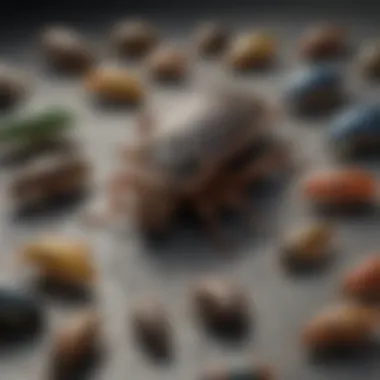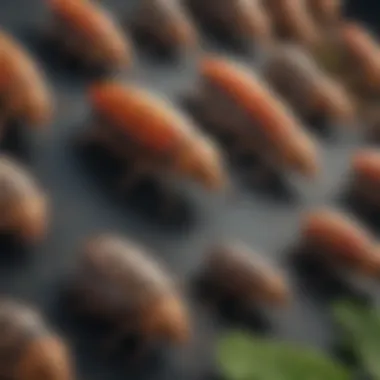R&D Pest Services Inc.: Comprehensive Pest Management


Intro
In today’s world, effective pest management is crucial for both the comfort of homes and the productivity of businesses. R&D Pest Services Inc. stands at the forefront of this vital industry, offering a range of solutions tailored to meet diverse needs. This article delves into the intricacies of pest identification, prevention strategies, and treatment options that R&D Pest Services provides. Understanding these aspects is key for homeowners and professionals alike, as they navigate the complexities of pest control.
Pest Identification
Pest identification is the first step in any pest management strategy. Recognizing the types of pests present in an environment can help in crafting an effective response. Common pests that R&D Pest Services often deals with include:
- Ants: These social insects are often seen in trails searching for food. Their presence can indicate food sources that are readily available.
- Roaches: Cockroaches are notorious for their ability to hide, but droppings and a musty odor are clear signs of an infestation.
- Termites: Subterranean termites often leave tiny mud tubes leading to their colonies, indicating property damage potential.
- Rodents: Mice and rats leave droppings and gnaw marks, often found in hidden areas like basements or attics.
Identifying the signs and symptoms of infestations is equally important. These can include:
- Unusual noises: Scratching sounds in the walls or ceilings can signal the presence of rodents or pests.
- Physical damage: Chewed wires, holes in walls, or damaged insulation could suggest a serious infestation needing immediate attention.
"The sooner a pest issue is identified, the more effectively it can be resolved, minimizing damage and associated costs."
Prevention Strategies
Effective prevention strategies are essential to maintaining a pest-free environment. R&D Pest Services promotes several home maintenance tips for preventing infestations. These include:
- Regular cleaning: Keeping a clean space reduces food sources for pests, making properties less attractive to them.
- Sealing entry points: Inspecting and repairing windows, doors, and any other gaps can prevent pests from entering.
- Proper waste management: Secure garbage bins and compost containers reduce odors that attract pests.
In addition, natural deterrents and barriers can enhance prevention efforts. These may include:
- Essential oils: Peppermint and eucalyptus oils can deter insects when used in sprays.
- Diatomaceous earth: This is a natural powder that harms insects when they contact it, creating a barrier against pests.
Treatment Options
When pests are already present, treatment becomes necessary. R&D Pest Services offers a comprehensive overview of treatment options available. Treatments can generally be categorized into chemical and natural methods.
Chemical Treatments
Chemical treatments are often effective for significant infestations. These involve:
- Insecticides: Targeted sprays can eliminate specific pests without harming humans or pets when used correctly.
- Baits and traps: These can lure pests and reduce their populations over time.
Natural Treatments
For those who prefer eco-friendly solutions, natural treatments are also available. This includes:
- Homemade remedies: Simple mixtures of vinegar and water can act as a deterrent for some insects.
- Biological control: Introducing natural predators can help manage pest populations without chemicals.
DIY Treatments
Homeowners often seek guidance for DIY treatments. Here is a simple step-by-step guide for a common issue, such as ant infestations:
- Locate nesting sites: Observe where ants are entering.
- Create a bait station: Use a mix of sugar and borax. Place it where you see activity.
- Monitor activity: Keep an eye on the bait to see if it brings in more ants.
- Seal entry points: Once you see a decrease, seal the paths ants used to enter.
Prolusion to R& Pest Services Inc.
R&D Pest Services Inc. plays a significant role in the field of pest management, an essential service that helps maintain the well-being of both homes and businesses. This introduction lays the groundwork for understanding the company's various offerings, its commitment to effective pest control, and the relevance of professional pest management.
The need for pest control is not new. Rather, it has become increasingly vital as urbanization expands and human habitats overlap more with natural environments. This intersection invites various pests, which can disrupt lives and cause damage. R&D Pest Services Inc. positions itself as a leader in this necessary sector, providing tailored solutions that address the unique pest challenges faced by homeowners and businesses alike.
Company Background
R&D Pest Services Inc. was founded with a clear vision: to create a safer, pest-free environment for its clients. With years of experience, the company has developed a robust portfolio of services designed to target both common and more complex pest issues. Staffed by a team of trained professionals, R&D Pest Services Inc. is dedicated to utilizing advanced techniques and reliable products. This combination ensures that they meet and exceed customer expectations.
The company focuses on continuous improvements and feedback from clients to refine its methodologies and enhance its offerings. Its reputation is nurtured through positive results, timely services, and a commitment to environmental safety.
Mission and Vision
At the core of R&D Pest Services Inc. lies a mission to eliminate pest problems effectively while promoting sustainable practices. The company recognizes that pest control should not only focus on immediate solutions, but also consider long-term prevention strategies. Their vision includes contributing to healthier living and working spaces, where pests pose minimal risk to human health and property.


This mission is realized through a dual approach: employing both proven pest control methods and advocating for education among clients. R&D Pest Services Inc. aims to empower homeowners and businesses with information that helps them understand pests and how to prevent infestations before they begin.
"R&D Pest Services Inc. is committed to safeguarding homes and businesses from pest threats, ensuring peace of mind for all clients."
Understanding Pest Management
Pest management is a crucial aspect of maintaining health and safety in both residential and commercial environments. The growing threat posed by pests necessitates a well-rounded understanding of how these organisms behave, reproduce, and interact with human environments. This knowledge allows homeowners and business operators to implement effective strategies that prevent infestations and manage existing problems. Understanding pest management encompasses several key elements, including pest identification, behavior, prevention strategies, and treatment options.
Importance of Pest Control
Effective pest control goes beyond eradication; it aims to create a sustainable environment. Pests can harm properties, spread diseases, and cause significant economic damage. For instance, termites can compromise structural integrity, while rodents can carry bacteria and viruses harmful to humans. Moreover, pest control can significantly enhance comfort and quality of life. A pest-free home reduces stress and contributes to a healthy living environment, promoting overall well-being.
Common Pests Targeted
Understanding the common pests targeted by pest control services can help in anticipating problems and implementing preventive measures. Here are some pests frequently addressed:
Termites
Termites are often cited as one of the most destructive pests. They feed on wood, leading to considerable damage to structures. The primary threat comes not only from their presence but from the difficulty of detecting them until damage is already substantial. Their ability to consume wood silently makes early intervention challenging. Addressing a termite problem effectively requires knowledge of their behavior and movement patterns. Regular inspections and treating affected areas early can save homeowners from costly repairs.
Rodents
Rodents, such as mice and rats, are notorious for their rapid reproduction and adaptability. They are attracted to food sources and can invade through the smallest of openings. Their droppings can contaminate food supplies, posing health risks. Rodents also have the potential to damage property by chewing through wires and insulation, which can lead to further complications. An integrated approach that combines sanitation, exclusion, and trapping is essential in managing rodent populations effectively.
Ants
Ants are social insects that often form large colonies, which can quickly become a nuisance. They tend to invade kitchens and pantries in search of food. While many species are harmless, some can deliver painful bites or sting. Understanding the species involved is key to addressing the problem, as different types of ants may require distinct approaches. For example, carpenter ants, which can nest in wood, need targeted treatment to eliminate the colony at its source.
Bed Bugs
Bed bugs have gained notoriety for their ability to quickly spread in living spaces, particularly in hotels and shared accommodations. These tiny insects take blood meals from humans during the night, leaving itchy welts as a result. The unique life cycle and resilience of bed bugs make them difficult to eliminate. It requires a comprehensive treatment plan involving cleaning, monitoring, and possibly professional eradication methods. Awareness and early detection are vital in controlling bed bug infestations.
Understanding your pest problem is the first step towards effective control. Knowledge leads to better prevention strategies and treatment methods.
Services Offered by R& Pest Services
The realm of pest control services is critical for both residential and commercial settings. These services help manage and mitigate pest-related issues, thus improving health and safety standards within any environment. R&D Pest Services Inc. stands out in the industry due to its comprehensive approach to pest control, combining various methods and technologies to provide effective solutions.
R&D Pest Services Inc. offers a diverse range of services tailored to meet the specific needs of its clients. Recognizing the diverse nature of pests and the unique challenges they present, the company emphasizes an integrated pest management strategy. This approach allows for a more effective response to pest infestations, significantly reducing risks to property and health.
Residential Pest Control Solutions
When it comes to residential areas, pest control is crucial for preserving the comfort and safety of homes. R&D Pest Services provides tailored pest control solutions intended for homeowners, focusing on various aspects of pest management. These include assessment, treatment, and ongoing prevention strategies.
Homeowners are often confronted with pests like ants, cockroaches, and termites. Prompt identification and treatment are essential in preventing these pests from damaging property or disrupting daily life. R&D Pest Services utilizes industry-tested techniques to eliminate infestations while ensuring minimal disruption to the household.
Commercial Pest Control Services
Businesses also face unique pest challenges that can affect their operations. In commercial spaces, the presence of pests can lead to significant economic repercussions, including loss of reputation and potential health violations. R&D Pest Services focuses on developing customized pest management programs for various industries, from restaurants to warehouses.
The methodology employed often involves thorough inspections to identify potential vulnerabilities. Following this, R&D might implement preventive measures alongside treatment protocols. Through an ongoing partnership, businesses can maintain a pest-free environment, which is vital for customer satisfaction and compliance with health regulations.
Emergency Pest Control
Pest emergencies can arise unexpectedly, often posing immediate threats to both health and property. R&D Pest Services is equipped to handle such situations swiftly. Their emergency pest control services are focused on quick response and effective resolution.
Whether it’s an influx of rodents or an unexpected bed bug infestation, the trained professionals at R&D Pest Services act immediately to assess the situation and implement appropriate measures. This responsiveness not only mitigates potential damage but also restores peace of mind for the clients affected.
"Effective pest control requires not just action but a tailored approach considering each unique situation and environment."
Pest Identification Techniques
Pest identification is a crucial component in effective pest management. Understanding the type of pest present is essential for formulating a proper response. This aspect is fundamental for both residential and commercial spaces, as different pests require specific management strategies. Homeowners must be able to recognize signs of infestation, and professionals must utilize various techniques to ensure precise identification.
Signs of Infestation


Recognizing the signs of pest infestation is often the first step in effective pest control. Here are some common indicators that pests may be present in your home:
- Droppings: The presence of fecal matter is usually among the first signs. For instance, rodent droppings tend to be small and dark, while cockroach droppings resemble black pepper.
- Gnaw Marks: Damage to wood, food packaging, or infrastructure is often a result of pests gnawing. This is especially true for rodents, which need to chew to keep their teeth from growing too long.
- Nests: Look for nests or burrows. Rodents will often create nests from shredded paper or fabric, while insects like pests may build visible nests outside the home.
- Unusual Sounds: If you hear scratching or scurrying noises, especially at night, this can indicate rodent activity.
- Damage to Plants: In gardens or landscaping, you may notice holes or other damage in plants that signify pest activity, whether from insects or larger animals.
Being aware of these signs can help in early detection, which is critical for effective management.
Use of Technology in Identification
Technology plays an increasing role in the identification of pests. Modern techniques allow for more accurate and speedy recognition of pest issues. Here are some notable technological advancements:
- Smart Traps: Equipped with sensors, smart traps can alert professionals when pests are detected. This technology reduces the need for regular checking, allowing for quicker interventions.
- Mobile Apps: There are various mobile applications available that help identify pests through images. Homeowners can use these apps to gain insights into the specific types of pests they might be dealing with.
- Remote Monitoring Systems: Some businesses utilize advanced monitoring systems that can track pest activity in real-time, enhancing the response time of pest control professionals.
- Infrared and Thermal Imaging: These tools can detect temperature changes associated with pest activity. For example, rodents often generate more heat than their environment, making it easier to identify hotspots.
Adopting these methods improves both the accuracy and efficiency of pest identification. This can lead to more effective management solutions, ultimately protecting homes and businesses from further infestation.
"An early detection of pest infestations can often prevent larger problems down the line, saving time and resources."
Effective Prevention Strategies
Effective prevention strategies are essential in maintaining pest-free environments in both homes and businesses. Rather than waiting for a pest infestation to occur, proactive measures can save time, resources, and potential damage. These strategies can significantly reduce the likelihood of pests entering and thriving in facilities.
When homeowners take action before pests become a problem, they are likely to notice several benefits, including a decrease in pest-related health issues and property damage. Preventative measures lead to lower pest control costs, as emergency treatments are often far more expensive than consistent maintenance and monitoring. Implementing good preventive practices can also ensure a healthy living environment for families and pets.
There are various considerations to keep in mind when discussing effective prevention strategies. Awareness of seasonal pest behavior plays a vital role, as certain pests are more active in specific seasons. Additionally, understanding the common entry points and nesting habits of various pests can help in taking appropriate preventive measures. Investing time in regular property inspections will go a long way in ensuring that any potential threats are identified early.
Homeowner Responsibilities
Homeowners play a crucial role in pest prevention. Active participation in routine maintenance can largely dictate a property’s vulnerability to infestations. Simple steps include keeping food stored properly and sealing cracks and crevices that may allow pests to enter.
- Food Storage: Ensuring that pantry items are sealed in airtight containers is fundamental. Dispose of garbage promptly and securely.
- Regular Cleanliness: Regular cleaning routines should include sweeping, vacuuming, and mopping floors to remove food particles that attract pests.
- Seal Entry Points: Inspect windows, doors, and vents for gaps. Use caulk or other sealing agents to close these openings, which can serve as entry points for pests.
- Yard Maintenance: Keep yards tidy by trimming bushes, picking up debris, and maintaining proper drainage to discourage pest habitats.
It's crucial that homeowners recognize their role in prevention. By taking these proactive steps, potential infestations can be significantly minimized.
Professional Preventive Measures
While homeowners can manage many aspects of pest prevention, professional intervention can enhance safety and effectiveness. Pest control experts bring specialized knowledge and tools that can prevent infestations more effectively than household methods alone.
- Regular Inspections: Pest control services can provide regular inspections to evaluate a property’s vulnerability. This service helps in identifying potential threats before they escalate into infestations.
- Integrated Pest Management (IPM): Professionals often use IPM frameworks, which combine various techniques to manage pests effectively and sustainably. This may involve biological control, habitat manipulation, and the use of resistant plant varieties.
- Customized Treatment Plans: Based on a property’s specific needs, pest control professionals can develop tailored prevention strategies that address unique issues. This ensures that the specific conditions of a property are taken into account, making treatments more effective.
- Ongoing Education: Pest control companies often keep up-to-date with the latest developments in pest management. This continuous learning helps in adapting strategies to effectively address emerging issues and pest behaviors.
"Proactive pest management is key in protecting both health and property from pest-related risks."
Treatment Methods and Solutions
In the field of pest control, selecting the right treatment methods and solutions is critical for the effectiveness of pest management. Both homeowners and professionals need to consider the specific pest challenges they face. Understanding the available options fosters informed decisions that not only address current infestations but also help prevent future occurrences. Pest treatment approaches can be categorized into chemical and natural solutions, each offering unique benefits and considerations.
Chemical Treatment Options
Chemical treatment options are widely used due to their effectiveness against a variety of pests. These treatments often employ potent substances designed to eliminate pests quickly.
Advantages of chemical treatments include:
- Rapid Action: Many chemical solutions work swiftly, providing immediate relief from pests.
- Broad Spectrum: Certain chemicals can target multiple types of pests, making them versatile for various infestations.
- Accessibility: Chemical treatments are readily available through many suppliers, and trained professionals can easily apply them.
However, homeowners should be aware of important considerations.
- Safety: Ensure that the chemical treatments used are safe for both people and pets. Always read product labels to understand any risks.
- Environmental Impact: Some chemicals can have adverse effects on the local ecosystem. Selecting products with minimal ecological footprints can be wise.
- Resistance: Overuse of certain chemicals can lead to pest resistance. Rotating treatment methods can help mitigate this issue.
"A well-informed approach to pest control is essential for long-term success and safety."
Natural and Organic Solutions
The demand for natural and organic pest control solutions has increased in recent years. These methods appeal to homeowners who are concerned about chemical exposure or who prefer environmentally friendly options.
Natural treatment methods can include:
- Essential Oils: Oils such as peppermint and tea tree can deter certain pests effectively.
- Diatomaceous Earth: This powdery substance is non-toxic to humans but lethal to insects with exoskeletons.
- Biological Control: Introducing natural predators, like ladybugs for aphids, can help manage pest populations sustainably.


Benefits of choosing natural or organic solutions include:
- Safety: Generally, they pose fewer health risks to humans, pets, and the environment.
- Long-term Management: Often, these solutions focus on sustainable practices that can reduce recurring infestations.
- Regulatory Support: Many consumers are increasingly supportive of natural solutions, aligning with a growing trend towards sustainability.
However, they may come with considerations:
- Slower Results: Often, natural solutions take longer to show effectiveness compared to their chemical counterparts.
- Limited Efficacy: They may not be as effective for severe infestations, requiring a combination of methods for complete control.
Role of Pest Control Professionals
The role of pest control professionals cannot be overstated. They serve as the frontline defenders against pests that can infiltrate homes and businesses. Their expertise is essential not only for effective eradication but also for implementing long-term prevention strategies. By choosing professionals, households and businesses gain access to trained specialists who understand pest behavior and are equipped with the necessary tools and knowledge to tackle infestations.
Pest control services often provide a safer environment. Many people are not fully aware of the potential health risks associated with common pests, such as rodents and insects. For instance, rodents can carry diseases that may affect your family's health. Professionals mitigate such risks by ensuring that pests are dealt with promptly and effectively.
Additionally, employing pest control experts can save time and minimize stress for homeowners. Many may attempt DIY solutions which can be ineffective or even dangerous. With the proper training, pest control teams can evaluate a situation quickly and decide on the best course of action.
Training and Certification
Training and certification are pillars of professionalism in pest control. These qualifications ensure that technicians have undergone extensive education about pest behaviors and applicable control methods. Furthermore, certified pest control professionals understand local regulations and safety protocols related to pesticide application.
In many regions, professionals must pass examinations and gain practical experience before receiving licensing. This rigorous process guarantees that only qualified individuals can provide pest control services.
Continuous Education and Research
Continuous education and research are vital for pest control professionals. The pest control landscape is constantly evolving due to changing pest behaviors, climate shifts, and new pest management technologies. Professionals must stay updated with the latest in pest management practices, including innovative treatment strategies and eco-friendly alternatives.
Training seminars, online courses, and industry conferences are avenues for ongoing learning. Moreover, engaged professionals often conduct or participate in research studies aimed at improving pest control methods. Through this constant cycle of education and research, pest control professionals are equipped to deliver the most effective solutions, benefitting both their businesses and their clients.
"Professional pest control is not just about removing pests; it is about understanding them and preventing future infestations."
Myths and Misconceptions about Pest Control
Understanding the myths and misconceptions surrounding pest control is essential. These myths can lead to ineffective practices, unnecessary panic, or even harmful choices. Homeowners and business operators must have accurate knowledge about pest management to ensure their environments remain safe and pest-free. Recognizing these myths not only empowers individuals but also promotes a realistic approach to pest prevention and treatment.
Debunking Common Myths
Pest control is often subject to various myths and misconceptions. Addressing these is crucial for cultivating informed decisions. Here are a few common misconceptions:
- Myth 1: All pests are the same. This is not true. Different pests require different approaches. Understanding what type of pest you are dealing with is vital for effective control.
- Myth 2: DIY methods are always effective. While some DIY solutions can help, they are not always sufficient for major infestations. Professional methods are often more reliable.
- Myth 3: Pesticides are harmful and should be avoided at all costs. Many pesticides have been tested for safety, especially for residential use. The key is to use them correctly and follow label instructions.
Debunking these myths helps create a more realistic understanding of pest control, encouraging cooperative strategies between homeowners and professionals.
Understanding Pesticide Use
The topic of pesticide use is often surrounded by confusion and fear. Many homeowners believe that pesticides are hazardous and should be avoided. However, this is a simplification of a more complex issue.
There are several important considerations regarding pesticide use:
- Safety Regulations: Pesticide products are subject to safety evaluations by regulatory agencies before approval for public use. This includes assessments of potential health risks to humans and the environment.
- Proper Application: The key to pesticide safety is application. Following instructions on the label ensures that pesticides are used effectively and with minimal risk.
- Integrated Pest Management (IPM): This strategy combines various methods for pest control, including pesticides, in a balanced approach. This reduces reliance on chemical solutions and promotes safer practices.
"Educating oneself about pesticide use is an investment in both safety and efficacy when it comes to controlling pests."
The End
In the realm of pest management, the conclusion of this article serves as a critical synthesis of the information detailed earlier. It draws upon the various aspects of R&D Pest Services Inc., emphasizing the significance of thorough pest control strategies for both homes and commercial settings. Understanding pest management is not merely about eliminating unwanted insects or rodents; it encompasses a broad spectrum of knowledge that includes identification, prevention, and treatment methodologies. The effectiveness of pest management systems can lead to healthier living environments, protecting homes from structural damages caused by pests like termites and improving mental well-being by reducing the stress associated with infestations.
Recap of Key Points
As we summarize the crucial elements discussed:
- R&D Pest Services Inc. provides comprehensive pest management solutions tailored to residential and commercial needs. Their services address every stage of pest control from identification to prevention and treatment.
- Understanding pest behavior and the specific traits of common pests is crucial for effective control measures. The article covered prevalent pests such as termites, rodents, ants, and bed bugs.
- Different treatment methods, including chemical and organic solutions were explored, showcasing the balance between effectiveness and environmental consideration.
- The importance of pest control professionals is highlighted, focusing on their training, certification, and the constant education required to stay updated on evolving pest management strategies.
- Myths surrounding pest control, particularly about pesticide use, were debunked, providing clarity on misconceptions that often lead to ineffective DIY solutions.
In a nutshell, thorough pest management not only preserves the physical integrity of properties but also enhances peace of mind for homeowners and business operators alike.
Future of Pest Control Services
Looking ahead, the future of pest control services will heavily rely on advancements in technology and a deeper understanding of pest ecology. As urbanization continues and climate changes impact pest behaviors, it calls for innovative solutions that adapt to these challenges.
- Smart technology: The integration of IoT devices for pest monitoring can revolutionize how infestations are detected and managed. Sensors that alert homeowners to pest activities in real-time could reduce the need for extensive treatments, aligning with sustainable practices.
- Biological control methods: These methods involve leveraging natural predators to manage pest populations. This could see a rise in acceptance as public awareness of chemical treatments grows.
- Regulatory changes: As environmental movements gain momentum, pest control professionals may face stricter regulations on pesticide use. This will encourage the development of more eco-friendly solutions.
- Consumer education: Enhanced awareness among homeowners about the importance of proactive pest management can lead to increased demand for services that focus on prevention rather than treatment.
As R&D Pest Services Inc. evolves in response to these trends, they will likely play a pivotal role in shaping the future landscape of pest management, ensuring safe, effective, and sustainable solutions for all.



